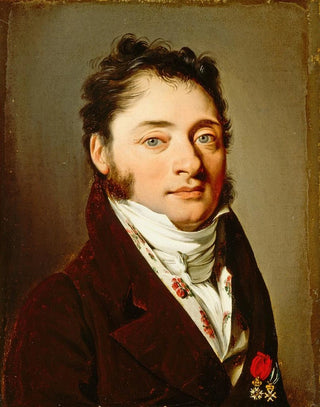Art print | Portrait of a gentleman - Louis Léopold Boilly


View from behind

Frame (optional)
Louis Léopold Boilly’s “Portrait of a Gentleman” is a masterpiece that embodies the elegance and sophistication of 18th-century French art. This painting, with its striking realism and thoughtful composition, immerses viewers in an era when portraiture was at its peak. Boilly, a master of the genre, succeeds in capturing not only the physical appearance of his subject but also the very essence of his personality. The delicate light caressing the gentleman’s face, along with the meticulous details of his attire, evoke an atmosphere of nobility and refinement. This work, with its timeless charm, continues to fascinate those who contemplate it, offering a window into a rich past full of history and culture.
Style and uniqueness of the work
Boilly’s style is distinguished by its realistic approach and ability to grasp the nuances of human expression. In “Portrait of a Gentleman,” each brushstroke seems to tell a story, with every shadow and reflection contributing to creating a lively and dynamic image. The artist uses a subtle color palette, blending warm and cool tones to add depth to the painting. The posture of the gentleman, slightly turned towards the viewer, invites an almost intimate interaction. This compositional choice, combined with meticulous attention to detail in clothing and accessories, makes this work a shining example of 18th-century portrait art. Boilly manages to transcend mere physical representation to offer a psychological interpretation of the character, making the painting all the more captivating.
The artist and his influence
Louis Léopold Boilly, born in 1761, is an iconic figure in French painting. His work sits at the crossroads between Neoclassicism and Romanticism, and he is recognized for his ability to combine impeccable technique with artistic sensitivity. Boilly established himself in the artistic circles of his time, influencing many artists with his innovative vision of portraiture. His use of light and color, as well as his capacity to capture everyday life, opened new avenues in the depiction of subjects. By exploring themes such as fashion, the

Matte finish

View from behind

Frame (optional)
Louis Léopold Boilly’s “Portrait of a Gentleman” is a masterpiece that embodies the elegance and sophistication of 18th-century French art. This painting, with its striking realism and thoughtful composition, immerses viewers in an era when portraiture was at its peak. Boilly, a master of the genre, succeeds in capturing not only the physical appearance of his subject but also the very essence of his personality. The delicate light caressing the gentleman’s face, along with the meticulous details of his attire, evoke an atmosphere of nobility and refinement. This work, with its timeless charm, continues to fascinate those who contemplate it, offering a window into a rich past full of history and culture.
Style and uniqueness of the work
Boilly’s style is distinguished by its realistic approach and ability to grasp the nuances of human expression. In “Portrait of a Gentleman,” each brushstroke seems to tell a story, with every shadow and reflection contributing to creating a lively and dynamic image. The artist uses a subtle color palette, blending warm and cool tones to add depth to the painting. The posture of the gentleman, slightly turned towards the viewer, invites an almost intimate interaction. This compositional choice, combined with meticulous attention to detail in clothing and accessories, makes this work a shining example of 18th-century portrait art. Boilly manages to transcend mere physical representation to offer a psychological interpretation of the character, making the painting all the more captivating.
The artist and his influence
Louis Léopold Boilly, born in 1761, is an iconic figure in French painting. His work sits at the crossroads between Neoclassicism and Romanticism, and he is recognized for his ability to combine impeccable technique with artistic sensitivity. Boilly established himself in the artistic circles of his time, influencing many artists with his innovative vision of portraiture. His use of light and color, as well as his capacity to capture everyday life, opened new avenues in the depiction of subjects. By exploring themes such as fashion, the






